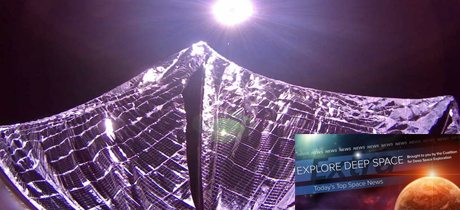In Today’s Deep Space Extra… NASA could be challenged in its quest to return to the lunar surface with human explorers in 2024 without seeking funds from other programs if Congress does not approve additional annual funds. Scientists rally to support more “one year” missions to the International Space Station (ISS) to unveil the health challenges of long missions to deep space faced by astronauts.
Human Space Exploration
NASA looking at “hard decisions” within its budget to pay for Artemis plan
Ars Technica (6/3): Though NASA’s leadership has the desire to fund an accelerated human return to the lunar surface from 2028 to 2024 without taking funding from other parts of the agency and in particular its science programs, such a move may be unavoidable. During a meeting of NASA’s Advisory Council last Friday, Bill Gerstenmaier, NASA associate administrator for Human Exploration and Operations, said the agency may have no other choice. The White House recently requested Congress for $1.6 billion in addition to the $21 billion it is seeking for the 2020 budget year to pursue the 2024 goal.
5 interesting things to know about NASA’s groundbreaking twin study
KPRC-TV of Houston (6/3): In April, 10 research teams reported findings from the first ever genetic study of identical twins, one who spent 340 days aboard the International Space Station (ISS), while the other pursued life on the ground. Both Scott and Mark Kelly are now retired NASA astronauts. On Monday, representatives from the teams discussed the highlights. The body is stressed down to the genetic level but returns to normal for the most part after returning to Earth. Researchers summarized plans to launch 10 more astronauts on similarly long missions to the Station to learn more about how long missions to Mars could challenge the physical and mental performance of future human explorers.
Dragon completes cargo return mission with splashdown in Pacific
NASA (6/3): NASA’s 17th NASA contracted Dragon re-supply mission to the International Space Station (ISS) was successfully completed late Monday, with a Pacific Ocean splashdown and recovery off the southern coast of California. The freighter, which was launched May 4 with 5,500 pounds of crew supplies and experiments, returned with a 4,200 pound payload, much of it science intended to better understand how humans respond physically to spaceflight.
Space Science
Sailing on sunbeams: Planetary Society’s LightSail 2 to soar higher than Space Station
Space.com (6/3): Among the payloads set to launch June 22 aboard a SpaceX Falcon Heavy from NASA’s Kennedy Space Center (KSC) is the Planetary Society’s LightSail 2, an small satellite demonstrator equipped with a solar sail that when deployed is as large as a boxing ring. Light Sail 2 is to spend a month demonstrating whether photons from the sun can strike the sail with enough momentum to raise its altitude. The overall mission is designated as the Department of Defense’s (DOD) Space Test Program-2, which will carry 24 spacecraft in all for deployments in three different orbits for a range of activities.
Rovers on Mars should be searching for rocks that look like pasta; they’re almost certainly created by life
Universe Today (6/3): A university of Illinois researcher has offered an intriguing strategy for looking for past signs of microbial life on Mars. It’s the crystallization of a calcium carbonate rock with a characteristic fettuccine like appearance rendered by interactions with a hardy bacteria.
Other News
Defanging the Wolf Amendment
The Space Review (6/3): Soon, the U.S. House will take up a 2020 appropriations measure for NASA. As it has for eight years, the legislation includes a restriction on NASA, the National Space Council and White House Office of Science and Technology Policy from collaborating on a bilateral basis with China or a Chinese company. Some are wondering if it’s time to take a longer view.
National Geospatial Intelligence Agency challenged to keep up with volatile world
SpaceNews.com (6/3): The U.S. National Geospatial Intelligence Agency faces a security environment that is more complex, interconnected and as volatile as ever in modern times, new director Vice Admiral Robert Sharp told a 2019 GEOINT audience gathered in San Antonio, Texas, on Monday. “NGA needs to mitigate the element of surprise by improving its ability to understand the world and anticipate future events,” he said. “We’re committed to modernizing our IT infrastructure, collection services, networks, training and business practices. We’ve got to keep up with the deluge of data.”

